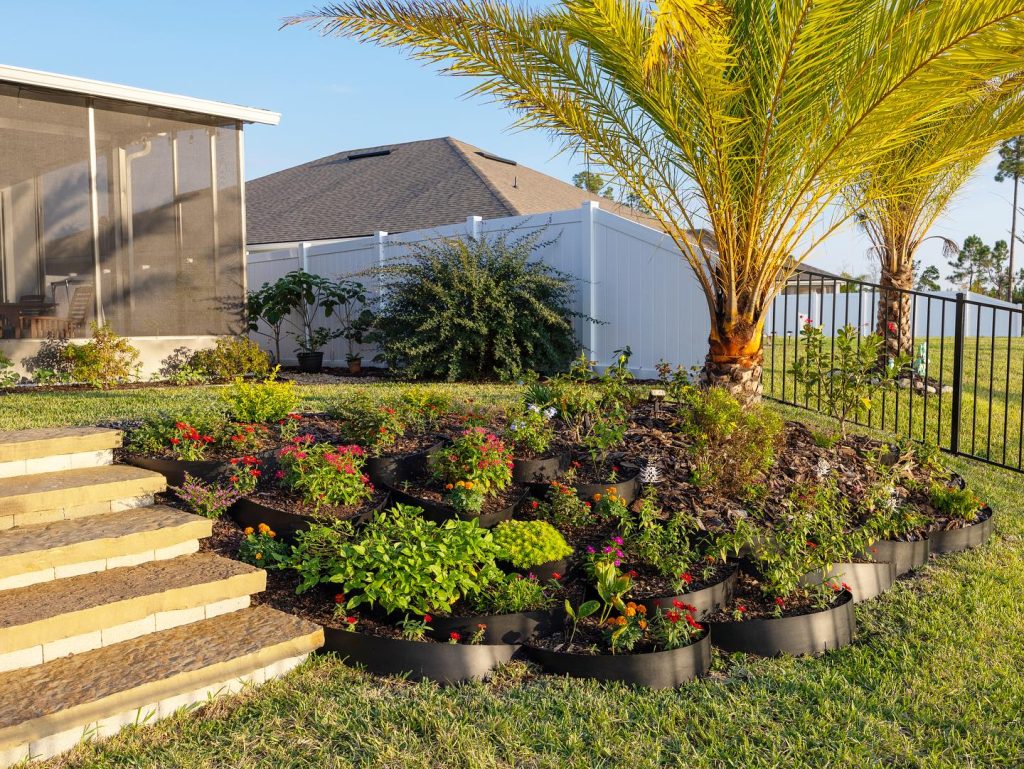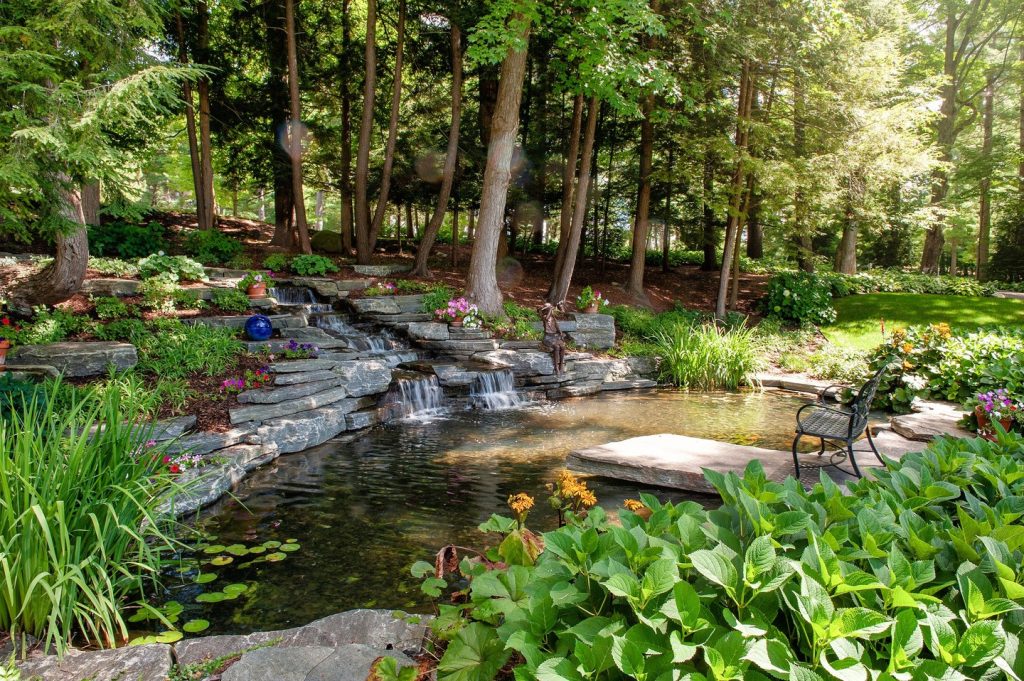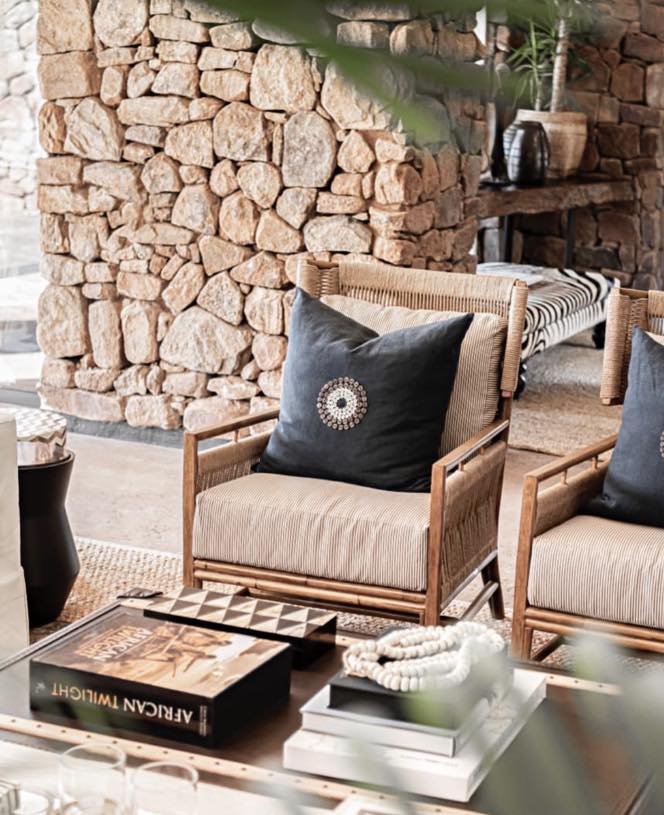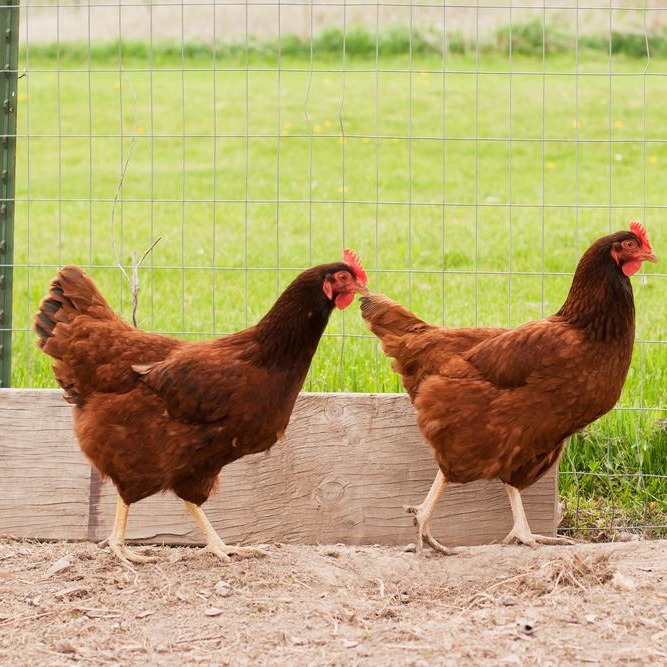23 Steep Hill Landscaping Ideas That Will Transform Your Outdoor Space
Landscaping a steep hill can feel like a daunting task, but with the right approach, it can become one of the most beautiful features of your home. Whether you’re dealing with a small incline or a dramatic slope, there are plenty of ways to make your hillside both functional and visually stunning.
In this article, we’re going to explore 23 inspiring landscaping ideas to help you make the most of your sloped yard. From retaining walls and terraced gardens to water features and outdoor lighting, you’ll find something to suit every style and budget.
1. Terraced Garden Beds

A terraced garden is one of the most effective ways to manage a steep hill. By cutting the hill into several flat areas, you create multi-level platforms where you can grow a variety of plants, flowers, or even vegetables. These garden beds help to prevent soil erosion while also making it easier to tend to your plants.
Terracing is typically achieved by using materials like stone, wood, or concrete to build retaining walls that hold each level in place. For an added touch, consider planting ground covers or creeping plants like ivy or thyme along the edges of each level. This will add softness and texture, giving the garden a more natural look.
Another benefit of terracing is that it can break up an otherwise monotonous landscape, creating visual interest and dimension. Each level provides a new opportunity to showcase different types of plants, creating a diverse and colorful outdoor space.
2. Stone Retaining Walls

A classic option for any sloped yard, stone retaining walls provide both function and beauty. These walls are designed to hold back the earth and prevent soil erosion, but they also serve as a striking feature in your garden. With a range of stone types available, from rustic fieldstone to sleek, modern granite, you can choose materials that complement the overall aesthetic of your outdoor space.
Stone retaining walls work particularly well for creating terraced garden beds, as they can be stacked to form stable levels. They also provide a sense of permanence and timelessness to the landscape. For added visual interest, consider incorporating different textures or finishes in the stone, or adding built-in planters for flowers or succulents along the top of the wall.
3. Staircase with Planters

If your hillside is too steep to simply plant directly into the slope, creating a staircase with built-in planters is a fantastic solution. This idea combines practicality with beauty, as it allows you to create safe access to the top of the hill while adding space for greenery and flowers.
A staircase can be constructed from a variety of materials, including stone, wood, or even concrete, and can be designed with wide, shallow steps to prevent any trips or falls. Planters can be built into the sides of the stairs or placed on the steps themselves. Plant low-maintenance flowers, herbs, or succulents to fill the space with color and texture.
This solution is perfect for those who want to incorporate gardening into their hillside without sacrificing safety or convenience. Plus, it adds a charming and functional element to your outdoor landscape.
4. Cascading Water Feature

There’s something incredibly soothing about the sound of water cascading down a hill. A cascading water feature can turn a simple slope into an elegant focal point. Waterfalls or streams can be created using natural stones, pebbles, and small boulders, with water gently trickling down to a pond or basin at the base of the hill.
This idea works beautifully for those looking to create a serene, Zen-like atmosphere in their backyard. The flowing water will not only add a visual appeal but also create a calming sound that enhances the overall ambiance of the space. Additionally, the water feature can help with erosion control, as it helps to guide rainwater away from the slope.
5. Wildflower Meadow
Source:
For a low-maintenance yet stunning landscape, consider turning your steep hill into a wildflower meadow. This option is ideal for homeowners who want a natural, rustic look that requires little upkeep. Wildflowers are resilient and can thrive in difficult conditions, making them perfect for slopes.
By selecting a mix of native wildflowers suited to your climate, you can create a colorful and dynamic hillside garden that changes throughout the seasons. Wildflowers attract beneficial pollinators like bees and butterflies, making them a great option for eco-conscious gardeners. In addition, wildflower meadows help to control soil erosion and can even improve the quality of the soil over time.
6. Rustic Timber Steps
Source:
Wooden steps made from natural timber are an excellent choice for a steep hill if you’re looking to add a rustic, natural touch to your landscape. Timber steps blend seamlessly with the surrounding environment and create a warm, welcoming vibe.
You can place these steps at an angle along the hill to create a winding path, or opt for a more linear design. The steps can be constructed using treated lumber or logs from fallen trees, depending on the aesthetic you want. For added visual interest, you could include small gravel or mulch between the steps to create a more textured look.
Timber steps can be paired with lush greenery or climbing vines to soften the edges and create a more organic feel. This type of pathway is not only functional but also a charming addition to your backyard.
7. Tiered Vegetable Garden
Source:
If you’re a fan of homegrown produce, a tiered vegetable garden is a great way to make the most of your sloped yard. By creating multiple planting levels, you can grow a variety of fruits, vegetables, and herbs in a more organized and accessible way.
Tiered vegetable gardens can be constructed using a variety of materials, including wood, stone, or even recycled materials like pallets. Each tier should be wide enough to accommodate a row of plants, and you can use mulch or straw to help retain moisture and control weeds. This design also allows you to stagger planting times, ensuring a constant harvest throughout the growing season.
Not only does a tiered vegetable garden provide fresh produce, but it also gives your hill a functional and visually appealing purpose. It’s a great way to blend utility with beauty in your landscaping.
8. Native Plant Landscaping
Source:
One of the easiest and most sustainable ways to landscape a steep hill is to incorporate native plants. These plants are well-adapted to the local climate and require minimal care, making them ideal for sloped yards.
Native plants, such as coneflowers, black-eyed Susans, and lavender, can be used to create a vibrant and sustainable garden. Their deep root systems also help with soil stabilization, preventing erosion and improving the health of your landscape. Many native plants also attract local wildlife, such as birds, bees, and butterflies, which further enhances the ecosystem of your yard.
By choosing plants that naturally thrive in your region, you can create a landscape that is both beautiful and environmentally friendly.
9. Rock Garden Layers
Source:
Rock gardens are an excellent choice for steep hills, especially if you’re looking for something that’s both visually interesting and low-maintenance. The varying sizes of rocks create a dynamic texture, and they can help manage water runoff, keeping the hill from eroding.
You can create a rock garden by placing stones of different shapes and sizes in layers along the hillside. Fill in the gaps with hardy plants, such as succulents, ground covers, or alpine flowers. These plants thrive in the dry, rocky conditions and will add pops of color against the muted tones of the stones.
Rock gardens can be particularly striking when you choose plants with contrasting textures, like feathery ferns next to smooth stones or spiky succulents paired with rounded pebbles. This combination creates visual interest and brings the natural beauty of the outdoors into your garden.
10. Sculptural Retaining Boulders
Source:
For a more modern, artistic take on hillside landscaping, consider using large sculptural boulders as retaining walls or focal points. These bold, oversized rocks can serve as both functional and decorative elements in your landscape design.
Sculptural boulders can be strategically placed to define different sections of the yard or to create dramatic focal points. Pairing these rocks with other landscaping features, such as grasses or tall shrubs, will enhance their sculptural appeal. This style works particularly well in modern or minimalist gardens, where the focus is on clean lines and natural materials.
11. Ground Cover Galore
Source:
Ground cover plants are a fantastic solution for steep hillsides, as they help to prevent erosion and keep the soil in place. Low-growing plants like creeping thyme, clover, or sedum are perfect for this purpose, as they spread quickly and thrive in a variety of conditions.
By planting a dense layer of ground cover, you can reduce the need for lawn care and add a lush, green texture to your slope. These plants will also require less water and maintenance than traditional grass lawns, making them an eco-friendly choice.
Ground cover also acts as a living mulch, keeping the soil moist and cool while preventing weeds from taking over. This makes it an ideal choice for those looking to create a low-maintenance and sustainable hillside garden.
12. Winding Gravel Pathway
Source:
A winding gravel pathway is a simple yet effective way to enhance the look of your sloped yard. The winding design adds movement to the landscape, while the gravel helps with drainage and erosion control. Plus, it provides a safe way to navigate your hill without damaging your plants.
You can line the edges of the gravel path with stones, low hedges, or flowers to create a more polished look. The pathway can lead to a seating area, a garden, or even a small pond, adding both functionality and beauty to your landscape.
Gravel paths are also relatively easy to install and maintain, making them a cost-effective solution for steep hillsides. They add texture and interest without overwhelming the space.
13. Pergola on a Platform
Source:
If you want to make the most of your steep hill, a pergola on a raised platform can provide a flat area for entertaining or relaxation. By building a wooden deck or platform halfway up the hill, you can create a perfect spot for outdoor dining or lounging.
The pergola structure adds shade and style, creating a cozy atmosphere that allows you to enjoy the view from a higher vantage point. You can drape vines like wisteria or grapevines over the pergola to enhance its visual appeal and create a more intimate, garden-like feel.
This elevated seating area offers both functionality and aesthetics, allowing you to enjoy the beauty of your sloped landscape in comfort.
14. Mini Vineyard
Source:
If your steep hill faces south or enjoys a lot of sunshine, why not transform it into a mini vineyard? Growing grapes on a slope is an ideal way to take advantage of the natural incline and create a unique outdoor feature. Vineyards are not only aesthetically stunning, but they also thrive on slopes, as the angle allows for better drainage and sun exposure.
You can plant grapevines along trellises or arbors, guiding them upward and creating a charming, rustic look. Depending on the space, you can grow a mix of varieties—perhaps starting with a small section dedicated to wine grapes and another for table grapes or even ornamental vines. This project can also be expanded into a small wine-tasting area or an outdoor kitchen, adding even more functionality to your landscape.
Besides their beauty, vineyards also attract beneficial insects and wildlife, adding more layers of life to your hillside garden. Plus, imagine harvesting your own grapes for wine or homemade jams—talk about a rewarding landscaping project!
15. Sloped Zen Garden
Source:
For those looking for a tranquil, low-maintenance landscape, a Zen garden is an excellent choice for a steep hill. These minimalist gardens are designed to bring peace and order to your space through the strategic placement of rocks, gravel, and simple plantings.
To create a Zen garden on a slope, start by incorporating natural materials like smooth stones, large boulders, and fine gravel to mimic the flowing lines of water or ripples on the sand. Choose plants like bamboo, moss, or ornamental grasses that thrive in your region and offer a soft contrast to the hard lines of the rocks. The gentle sound of wind or water will further add to the calming effect of the space.
A sloped Zen garden not only helps to prevent soil erosion but also provides a peaceful retreat where you can meditate, unwind, or simply enjoy the beauty of nature. This is a perfect idea for those looking to combine aesthetics with mindfulness.
16. Flowering Shrub Borders
Source:
Create beautiful, colorful borders along your steep hill with flowering shrubs that can add structure and vibrancy to your landscape. Flowering shrubs like hydrangeas, lilacs, and azaleas are perfect for sloped areas, as they have strong root systems that help to stabilize the soil while providing visual appeal.
These shrubs can be planted in clusters to create vibrant splashes of color or used as hedges to outline pathways or garden beds. The best part about flowering shrubs is that they require little maintenance, yet they reward you with rich blooms year after year. For a more layered look, mix in some ground cover plants or taller perennial flowers in between the shrubs.
Flowering shrub borders can be a beautiful way to soften the harsh lines of a slope and add dimension and texture to your hill. These plants will not only help prevent erosion but also bring seasonal color to your garden throughout the year.
17. Rain Garden
Source:
A rain garden is a sustainable landscaping feature designed to manage stormwater runoff, and it’s a perfect addition to a steep hill. This type of garden captures rainwater and allows it to soak into the ground rather than running off into storm drains, which helps prevent erosion and flooding.
To create a rain garden on a slope, start by identifying areas where water naturally collects. Choose plants that can handle both wet and dry conditions, such as ferns, rushes, or native grasses. Planting these species in a depressed area at the base of the hill will help slow down the flow of water, encouraging it to be absorbed into the soil.
Rain gardens are an eco-friendly solution to managing water runoff, and they can be beautifully designed to add an organic, lush feel to your steep hillside. Not only will they improve the health of your garden, but they also attract wildlife like birds, frogs, and beneficial insects.
18. Drystack Stone Steps
Source:
If you prefer a more natural look for your sloped yard, consider building drystack stone steps. These steps are made from stacked stones—no mortar needed—which creates a more organic, rustic feel. They work beautifully on slopes because they allow for natural drainage while providing a stable, secure footing.
Drystack stone steps can be used to create winding paths that lead to different levels of your hillside garden. The beauty of drystack stones is that they blend seamlessly into the landscape, making them perfect for those who want a low-key, natural appearance. You can line the sides of the steps with moss, ferns, or other shade-loving plants to soften the stone and create a serene atmosphere.
These steps are also durable and weather-resistant, making them a long-lasting investment for your hillside. The rugged look of the stacked stones adds texture and dimension to the garden, while their functionality ensures you can navigate your slope safely.
19. Spiral Herb Garden
Source:
A spiral herb garden is a fun and functional way to maximize space on a steep hill while adding some whimsy to your outdoor area. By planting herbs in a spiral pattern, you can create a visually interesting design that allows you to grow a variety of herbs in a small area.
To build a spiral herb garden, create a circular or spiral-shaped mound of soil, and line the edges with stones or bricks. As the mound rises, plant your herbs along the spiral, starting with the low-growing varieties at the outer edges and moving to taller ones at the center. This design not only helps conserve space but also makes it easier to tend to your plants, as the spiral can be accessed from multiple angles.
Herbs like rosemary, thyme, lavender, and basil thrive in well-drained soil and sunny conditions, making them perfect for a hillside garden. A spiral herb garden is a fantastic way to combine practicality with beauty, creating a fragrant and edible landscape on your sloped yard.
20. Deck Overlook
Source:
Transform the top of your hill into a relaxing retreat with a deck overlook. By building a deck at the highest point of your slope, you can take full advantage of the view while creating a space for dining, lounging, or entertaining.
A deck overlook allows you to make the most of your hillside, offering a flat, stable surface in contrast to the steep incline below. Consider using weather-resistant materials like composite wood or pressure-treated lumber to ensure that your deck stands the test of time. Add outdoor furniture, like comfortable chairs and a table, to make the space more inviting.
To enhance the ambiance, add some lighting along the perimeter of the deck, or plant climbing vines like wisteria or jasmine to give the space a cozy, garden-like atmosphere. A deck overlook is a perfect place to enjoy your garden from above and take in the beauty of your entire landscape.
21. Vertical Garden Wall
Source:
If your steep hill is on the smaller side, you may want to consider a vertical garden wall. Vertical gardens make use of vertical space, allowing you to grow plants in narrow or sloped areas that would otherwise be hard to plant in.
These garden walls are made by mounting planter boxes or a grid system to a wall or trellis, and they can be filled with flowers, herbs, or even vegetables. Vertical garden walls are perfect for those looking to add greenery without taking up too much space. They can also help improve air quality and provide a stunning focal point on your sloped hillside.
Vertical garden walls come in a variety of styles and materials, so you can choose one that matches your overall design. They are particularly ideal for modern or urban gardens and can be customized with different plants for a personalized touch.
22. Outdoor Lighting Features
Source:
Highlight the beauty of your sloped garden and create a magical atmosphere by adding outdoor lighting features. Strategically placed lights can illuminate pathways, retaining walls, or plants, creating a warm, inviting ambiance after dark.
Consider using low-voltage LED lights along walkways, around retaining walls, or within garden beds to enhance the natural beauty of your hillside garden. Solar-powered lights are an eco-friendly option, and they’re easy to install, as they don’t require wiring. If you have trees or tall shrubs, string lights or uplighting can add drama and focus attention on these features.
Outdoor lighting not only adds visual interest but also improves safety by illuminating paths and steps, making it easier to navigate your landscape at night. Lighting is the perfect way to extend the enjoyment of your steep hill garden into the evening hours.
23. Children’s Hillside Slide
Source:
If you have kids or grandkids, why not turn a steep section of your yard into an exciting playground feature? A hillside slide can be a fun and safe way for children to enjoy the outdoors. You can have the slide custom-built, or there are pre-made kits available for backyard use.
A hillside slide adds an element of playfulness to your sloped yard while helping to utilize the natural incline. It’s a fun addition to your landscape that will keep the little ones entertained while also giving your hill a unique feature.
For safety, be sure to install soft landing material at the base of the slide, like rubber mulch or grass. Add some nearby seating for parents or family members to relax and watch the fun unfold.
Conclusion
Landscaping a steep hill doesn’t have to be an overwhelming challenge—it can be a rewarding project that transforms your backyard into a breathtaking outdoor space. Whether you’re looking to create a tranquil Zen garden, an edible vegetable patch, or a beautiful retaining wall, the possibilities are endless.
As you plan your hillside garden, think about your style, needs, and the level of maintenance you’re willing to commit to. From terraces and rock gardens to slides and water features, each idea offers a unique way to make the most of your slope. And with careful planning, you can create a space that’s both functional and visually stunning, adding both value and charm to your home.
Take your time, experiment with different ideas, and don’t be afraid to get creative—your dream hillside garden is waiting!







